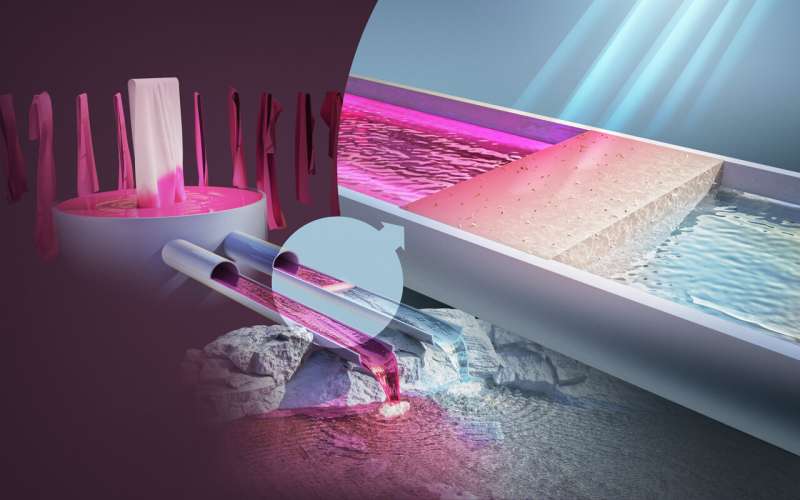There’s a dearth of direct beaver news but there is a bit of scientific news that sounds very beaverish:
![]()
New wood-based technology removes 80% of dye pollutants in wastewater
by Chalmers University of Technology

Researchers at Chalmers University of Technology, Sweden, have developed a new method that can easily purify contaminated water using a cellulose-based material. This discovery could have implications for countries with poor water treatment technologies and combat the widespread problem of toxic dye discharge from the textile industry.
Clean water is a prerequisite for our health and living environment, but far from a given for everyone. According to the World Health Organization, WHO, there are currently over two billion people living with limited or no access to clean water.
This global challenge is at the center of a research group at Chalmers University of Technology, which has developed a method to easily remove pollutants from water. The group, led by Gunnar Westman, Associate Professor of Organic Chemistry focuses on new uses for cellulose and wood-based products and is part of the Wallenberg Wood Science Center.
The researchers have built up solid knowledge about cellulose nanocrystals—and this is where the key to water purification lies. These tiny nanoparticles have an outstanding adsorption capacity, which the researchers have now found a way to utilize.
“We have taken a unique holistic approach to these cellulose nanocrystals, examining their properties and potential applications. We have now created a biobased material, a form of cellulose powder with excellent purification properties that we can adapt and modify depending on the types of pollutants to be removed,” says Gunnar Westman.
Absorbs and breaks down toxins
In a study recently published in the scientific journal Industrial & Engineering Chemistry Research, the researchers show how toxic dyes can be filtered out of wastewater using the method and material developed by the group. The research was conducted in collaboration with the Malaviya National Institute of Technology Jaipur in India, where dye pollutants in textile industry wastewater are a widespread problem.
The treatment requires neither pressure nor heat and uses sunlight to catalyze the process. Gunnar Westman likens the method to pouring raspberry juice into a glass with grains of rice, which soak up the juice to make the water transparent again.
“Imagine a simple purification system, like a portable box connected to the sewage pipe. As the contaminated water passes through the cellulose powder filter, the pollutants are absorbed and the sunlight entering the treatment system causes them to break down quickly and efficiently. It is a cost-effective and simple system to set up and use, and we see that it could be of great benefit in countries that currently have poor or non-existent water treatment,” he says.
![]() Wood in water. That sounds dam familiar!
Wood in water. That sounds dam familiar!
“Going from discharging completely untreated water to removing 80% of the pollutants is a huge improvement, and means significantly less destruction of nature and harm to humans. In addition, by optimizing the pH and treatment time, we see an opportunity to further improve the process so that we can produce both irrigation and drinking water. It would be fantastic if we can help these industries to get a water treatment system that works, so that people in the surrounding area can use the water without risking their health,” he says.
Can be used against other types of pollutants
Gunnar Westman also sees great opportunities to use cellulose nanocrystals for the treatment of other water pollutants than dyes. In a previous study, the research group has shown that pollutants of toxic hexavalent chromium, which is common in wastewater from mining, leather and metal industries, could be successfully removed with a similar type of cellulose-based material. The group is also exploring how the research area can contribute to the purification of antibiotic residues.
But let me tell you a little secret:
This is what beaver poop looks like… a mini sawdust snowball. This beaver poop is special though because this beaver poop is out of the water. Beavers almost always poop in the water, usually within the very ponds where they spend most of their time.

![]()
It may not be nanocrystal cellulose but it’s twice chewed and filters water real well!
We’ve been cleaning water for a long time but in Iowa some of us figured that we better start farming willow before there was nothing left to eat except corn!
 Walking sticks? Forgoing a bit of bark today for a whole willow in a few years is just the sensible thing to do when humans keep whacking down your favorite food! Watch the whole video though. It’s good!
Walking sticks? Forgoing a bit of bark today for a whole willow in a few years is just the sensible thing to do when humans keep whacking down your favorite food! Watch the whole video though. It’s good!






































